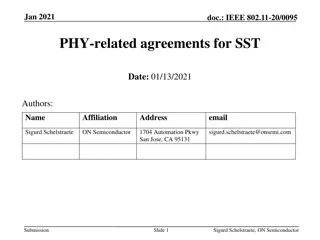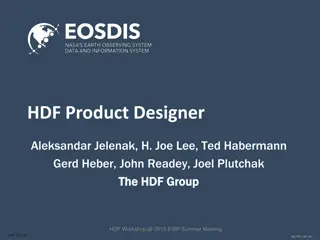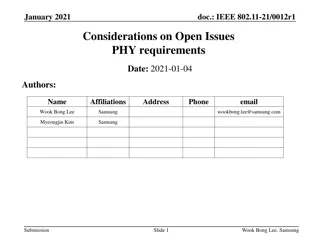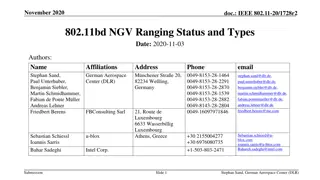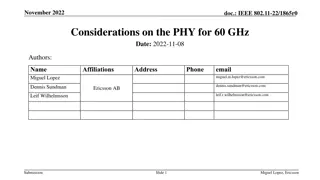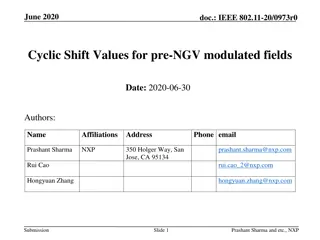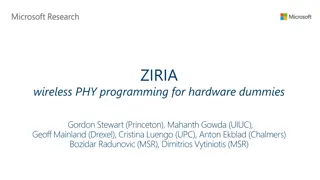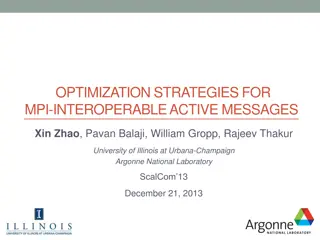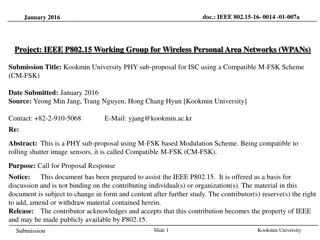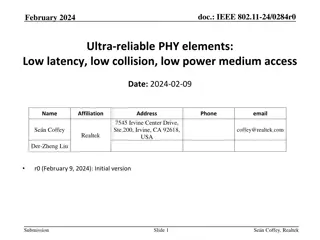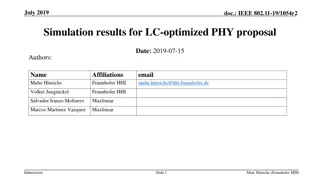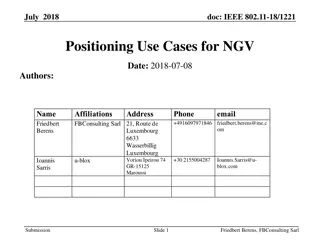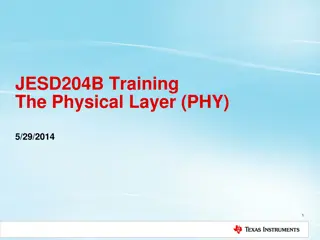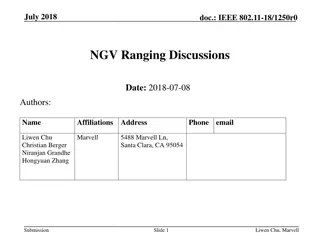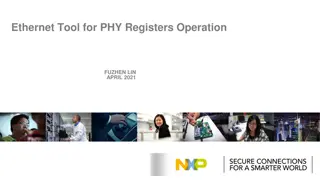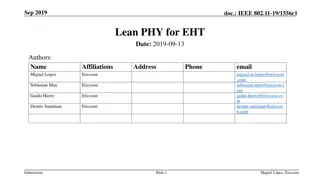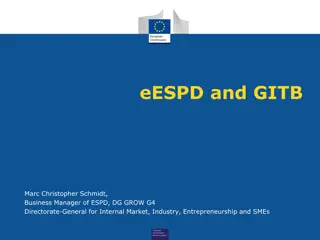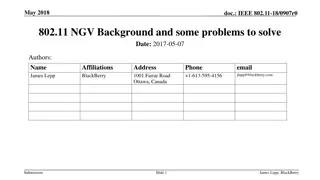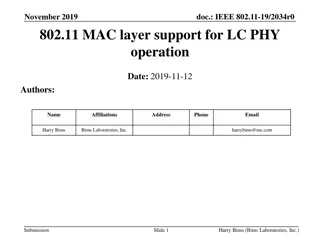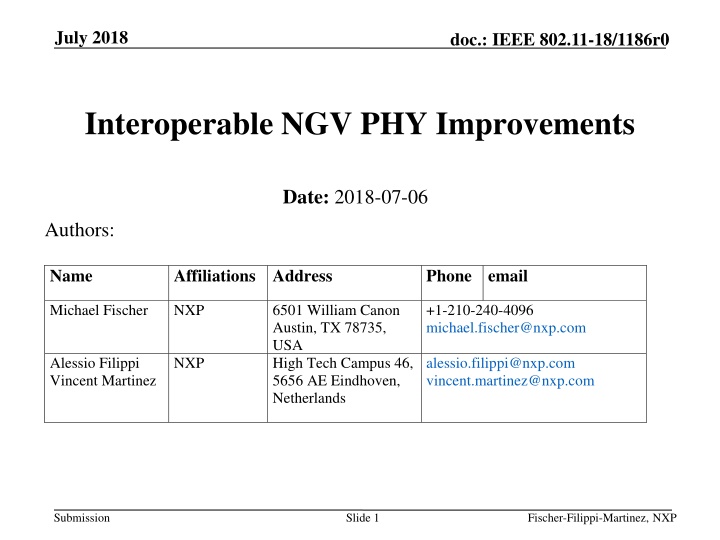
Improving NGV PHY Performance for V2X Communication
"Explore the proposed enhancements for NGV PHY in V2X communication to ensure interoperability with existing IEEE 802.11p systems. Discover TX RF and RX performance improvements alongside suggested new PHY features for NGV, aiming to enhance safety and efficiency in vehicle communication."
Download Presentation

Please find below an Image/Link to download the presentation.
The content on the website is provided AS IS for your information and personal use only. It may not be sold, licensed, or shared on other websites without obtaining consent from the author. If you encounter any issues during the download, it is possible that the publisher has removed the file from their server.
You are allowed to download the files provided on this website for personal or commercial use, subject to the condition that they are used lawfully. All files are the property of their respective owners.
The content on the website is provided AS IS for your information and personal use only. It may not be sold, licensed, or shared on other websites without obtaining consent from the author.
E N D
Presentation Transcript
July 2018 doc.: IEEE 802.11-18/1186r0 Interoperable NGV PHY Improvements Date: 2018-07-06 Authors: Name Affiliations Address Phone email Michael Fischer NXP 6501 William Canon Austin, TX 78735, USA High Tech Campus 46, 5656 AE Eindhoven, Netherlands +1-210-240-4096 michael.fischer@nxp.com alessio.filippi@nxp.com vincent.martinez@nxp.com Alessio Filippi Vincent Martinez NXP Submission Slide 1 Fischer-Filippi-Martinez, NXP
July 2018 doc.: IEEE 802.11-18/1186r0 Background Thousands of cars equipped with IEEE 802.11p are already on the road, and several major auto manufacturers have announced massive 802.11p roll-outs [including Toyota, VW, and GM] Improvements to IEEE 802.11p performance by NGV need to take into account the large number of 802.11p systems that will be in service by the time NGV is adopted and deployed NGV needs to be fully interoperable with legacy 802.11p Just having NGV stations be able to decode 802.11p signals is insufficient, especially for the safety channel We cannot segment the safety critical V2X applications between legacy and NGV users Millions of lives are at stake Submission Slide 2 Fischer-Filippi-Martinez, NXP
July 2018 doc.: IEEE 802.11-18/1186r0 Introduction The goal of the NGV activity should be to improve the system-level performance of V2X communication, without limiting communication to and from already deployed IEEE 802.11p equipment In this submission we will identify some opportunities to improve PHY performance while retaining full interoperability with the IEEE 802.11p PHY Submission Slide 3 Fischer-Filippi-Martinez, NXP
July 2018 doc.: IEEE 802.11-18/1186r0 Suggested new PHY features for NGV The improvements can be classified into the following categories: 1. TX RF improvements 2. RX performance improvements 3. Waveform design improvements Submission Slide 4 Fischer-Filippi-Martinez, NXP
July 2018 doc.: IEEE 802.11-18/1186r0 TX RF improvements Transmitter out-of-channel emissions can be reduced for better Multiple Channel Operation (MCO) Full interoperability with IEEE 802.11p The underlying waveform is not modified Vehicles using different Spectrum Emission Masks (SEM) can exchange messages Less interference between adjacent channels better SINR increased range & increased safety The standard should control usage of adjacent service channels so that they never reduce performance of the safety channel The more cars with a safer SEM, the safer the MCO Submission Slide 5 Fischer-Filippi-Martinez, NXP
July 2018 doc.: IEEE 802.11-18/1186r0 RX performance improvements Provide better performance of deployed systems, especially in real-life (not only in the lab) Fully backward-compatible Minimum sensitivity in static channels can be increased by about 6dB NGV should add various multipath fading sensitivity requirements for reliable mobility support in the field (with Doppler values aligned with application requirements up to 500 km/h) Propose to use the ITS-G5 V2V channel model for acceptance criteria Propose to use Doppler spectrum offset of 2731 Hz (500 km/h) Submission Slide 6 Fischer-Filippi-Martinez, NXP
July 2018 doc.: IEEE 802.11-18/1186r0 Waveform design improvements Retransmission of messages The exact same PPDU is retransmitted one, two, or three times Retransmissions are reduced as channel load increases (based on Channel Busy Ratio measurement) to avoid creating congestion Fully interoperable provides benefits to both 802.11p and NGV stations Retransmissions seen as standalone messages by 802.11p stations Performance improvement due to channel diversity (1 to 2 dB) Additional messages will be naturally filtered by application Filtering of duplicate messages is already performed by higher protocol layers no software update needed Message and retransmissions can be combined by NGV stations Combining at LLR levels for example +4 dB performance boost for 1 retransmission, +7 dB performance boost for 3 retransmissions Submission Slide 7 Fischer-Filippi-Martinez, NXP
July 2018 doc.: IEEE 802.11-18/1186r0 Example with three retransmissions Submission Slide 8 Fischer-Filippi-Martinez, NXP
July 2018 doc.: IEEE 802.11-18/1186r0 Initial simulation results Simulations with one retransmission indicate ~1 dB improvement for 802.11p stations and ~4 dB improvement for NGV stations Should be understood as Boolean OR of the CRC-pass results , we take the best of the 2 tries: - trans#1 FAIL + trans#2 FAIL = FAIL - trans#1 FAIL + trans#2 PASS = PASS - trans#1 PASS + trans#2 FAIL = PASS - trans#1 PASS + trans#2 PASS = PASS Submission Slide 9 Fischer-Filippi-Martinez, NXP
July 2018 doc.: IEEE 802.11-18/1186r0 Adaptive retransmission control We propose to control the number of retransmissions (from 0 to 3) based on the congestion measurement of the channel, based on the Channel Busy Ratio (CBR, as described in ETSI TR 101 613) Measured CBR Number of retransmissions Traffic increase (vs 802.11p) Comment 0 No increase in traffic Congested environment situation. Retransmissions are disabled 0.6 [0.3 0.6[ 0 or 1 (*) x1 to x2 The number of retransmissions is gradually increased as the occupancy of the channel goes down. [0.2 0.3[ 1 x2 [0.15 0.2[ 2 x3 < 0.15 3 x4 (*) Number of retransmissions = 0 or 1 Retransmission = random value with probability of retransmission = p = (0.6-CBR)/0.3 For example, CBR=0.30 p = (0.60-0.30)/0.3 = 0.3/0.3 = 1 For example, CBR=0.15 p = (0.60-0.45)/0.3 = 0.15/0.3 = 0.5 For example, CBR=0.60 p = (0.60-0.60)/0.3 = 0/0.3 = 0 Submission Slide 10 Fischer-Filippi-Martinez, NXP
July 2018 doc.: IEEE 802.11-18/1186r0 Benefits These techniques deliver performance improvements while maintaining full interoperability with 802.11p These techniques provide improved communication even for 802.11p stations that do not implement NGV These techniques do not increase channel load in congested environments These techniques do not require changing higher layers of the ITS protocol stack Submission Slide 11 Fischer-Filippi-Martinez, NXP
July 2018 doc.: IEEE 802.11-18/1186r0 Summary It is mandatory to maintain full interoperability with legacy 802.11p equipment There are ways to improve overall channel efficiency for both the legacy 802.11 users and NGV users 1. TX RF improvements Reduce interference for better Multiple Channel Operation 2. RX performance improvements Ensure better performance of deployed systems 3. Waveform design improvements Retransmissions of messages, adaptive with channel loading Submission Slide 12 Fischer-Filippi-Martinez, NXP


